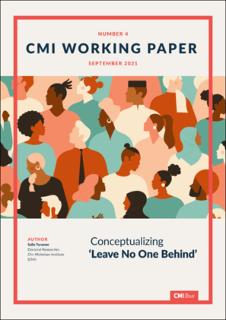| dc.contributor.author | Turunen, Salla | |
| dc.date.accessioned | 2021-09-13T16:24:14Z | |
| dc.date.available | 2021-09-13T16:24:14Z | |
| dc.date.issued | 2021-09-01 | |
| dc.identifier | oai:www.cmi.no:7881 | |
| dc.identifier.citation | Bergen: Chr. Michelsen Institute (CMI Working Paper WP 2021:04) 10 p. | |
| dc.identifier.isbn | 978-82-8062-784 | |
| dc.identifier.issn | 0804-3639 | |
| dc.identifier.uri | https://hdl.handle.net/11250/2776162 | |
| dc.description.abstract | Abstract
The term ‘leave no one behind’ is at the heart of the Sustainable Development Goals that were adopted by United Nations (UN) member states in 2015, and the phrase has frequently been used in the humanitarian realm. In its literal sense, leaving no one behind as an objective seems to be unattainable in contexts where humanitarian needs are overwhelming and humanitarian actors have limited resources and access. Therefore, instead of aiming to ‘leave no one behind’, the issue, rather, is who to leave behind and on what grounds. In light of this, this working paper explores the conceptualization of the term and the political dimensions that lie behind it.
Access the working paper in PDF format through the selection panel above
This publication is part of the project “Humanitarian Diplomacy: Assessing Policies, Practices and Impact of New Forms of Humanitarian Action and Foreign Policy” funded by the Research Council of Norway (project number 286859) and led by Antonio De Lauri at the Chr. Michelsen Institute. | |
| dc.language.iso | eng | |
| dc.publisher | Chr. Michelsen Institute | |
| dc.relation | CMI Working Paper | |
| dc.relation | WP 2021:04 | |
| dc.relation.ispartof | CMI Working Paper | |
| dc.relation.ispartofseries | CMI Working Paper WP 2021:04 | |
| dc.relation.uri | https://www.cmi.no/publications/7881-conceptualizing-leave-no-one-behind | |
| dc.subject | Empowerment | |
| dc.subject | 'Leave No One Behind' | |
| dc.subject | The United Nations | |
| dc.subject | Vulnerability | |
| dc.title | Conceptualizing ‘Leave No One Behind’ | |
| dc.type | Working paper | |
